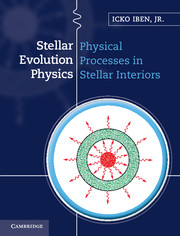Book contents
- Frontmatter
- Contents
- Preface
- Part I Introduction and overview
- Part II Basic physical processes in stellar interiors
- 3 Properties of and physical processes in main sequence stars–order of magnitude estimates
- 4 Statistical mechanics, thermodynamics, and equations of state
- 5 Polytropes and single zone models
- 6 Hydrogen-burning reactions and energy-generation rates
- 7 Photon–matter interaction probabilities, absorption cross sections, and opacity
- 8 Equations of stellar evolution and methods of solution
- Part III Pre-main sequence, main sequence, and shell hydrogen-burning evolution of single stars
- Index
- References
3 - Properties of and physical processes in main sequence stars–order of magnitude estimates
from Part II - Basic physical processes in stellar interiors
Published online by Cambridge University Press: 05 December 2012
- Frontmatter
- Contents
- Preface
- Part I Introduction and overview
- Part II Basic physical processes in stellar interiors
- 3 Properties of and physical processes in main sequence stars–order of magnitude estimates
- 4 Statistical mechanics, thermodynamics, and equations of state
- 5 Polytropes and single zone models
- 6 Hydrogen-burning reactions and energy-generation rates
- 7 Photon–matter interaction probabilities, absorption cross sections, and opacity
- 8 Equations of stellar evolution and methods of solution
- Part III Pre-main sequence, main sequence, and shell hydrogen-burning evolution of single stars
- Index
- References
Summary
Considerable insight into the interior characteristics of main sequence stars can be obtained by means of back of the envelope estimates. Such estimates are vital, for, while being engrossed in the construction of numerical solutions of the rigorous equations of stellar structure, one can lose sight of the basic physics underlying the equations.
In Section 3.1, the balance between the pressure gradient force and the gravitational force is used in conjunction with the equation of state for a perfect gas to estimate interior temperatures in homogeneous main sequence stars, emphasizing that the thermal energy of a particle in the deep interior of the star is comparable to the gravitational potential energy of a particle near the surface. In Section 3.2, the effects on the equation of state of electrostatic forces, electron degeneracy, and radiation pressure are examined, with the conclusion that the first two effects become important in stars less massive than the Sun and the third effect becomes important in stars considerably more massive than the Sun. In Section 3.3, theorems relating the binding energy of a star with the kinetic energy of material particles in the star and to the overall gravitational binding energy of the star are constructed.
In Section 3.4, three modes of energy transport – radiation, convection, and conduction – are explored. In the discussion of radiative flow, emphasis is placed on the microscopic physical processes involved in estimating the radiative opacity and a theorem relating stellar luminosity to stellar mass, mean molecular weight, and mean interior opacity is constructed.
- Type
- Chapter
- Information
- Stellar Evolution Physics , pp. 57 - 87Publisher: Cambridge University PressPrint publication year: 2012



